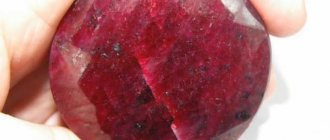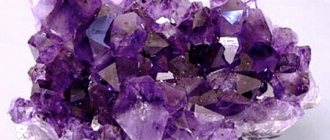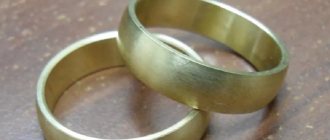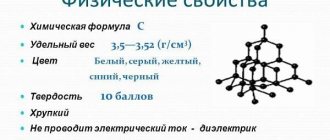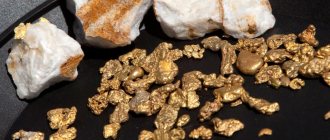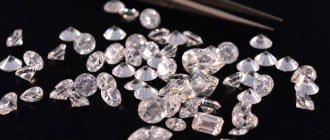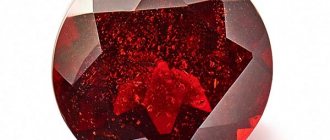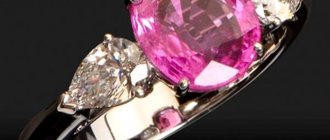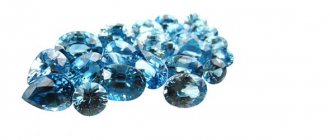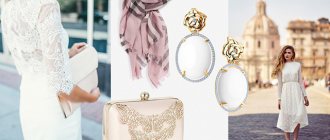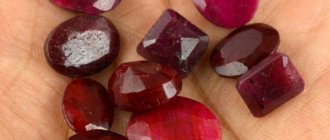Faceted ruby
Ruby
- mineral, Al2O3, a type of corundum red, transparent or translucent, also clouded to opaque, translucent at the edges. Outdated names are “lal”, “red yacht”. The red color is given by an admixture of chromium. Red corundums are called rubies, blue ones are called sapphires. “Star-shaped” varieties of ruby and sapphire with a well-defined asterism effect are processed as cabochons.
- Structure
- Properties
- Morphology
- Origin
- Application
- Classification
- Physical properties
- Optical properties
- Crystallographic properties
See also:
Ruby
- price and medicinal, magical properties
Physical properties and structure of diamond
STRUCTURE
Crystal structure of ruby
The crystal structure of Al2O3 is shown in the figure in the form of Al2O3 groups at the corners of two rhombohedrons that make up the unit cell. Despite its apparent complexity, it has a fairly simple structural diagram. Oxygen ions are in a dense hexagonal packing and are arranged in sheets perpendicular to the triple axis, superimposed on one another. Al cations are located between two such sheets in the form of hexagons (with an unoccupied center), filling two-thirds of the octahedral voids (i.e., the voids between six oxygen anions, three of which belong to one, and the other three, rotated relative to the first by 180°, - another sheet of oxygen ions). In this case, the groups of every three oxygen ions form a common face for two adjacent octahedra in adjacent sheets. It is characteristic that the oxygen sheets are superimposed on each other in such a way that in each column of octahedra two occupied ones also alternate with one unoccupied one, and the pairs of occupied octahedra form helical triple axes vertically.
PROPERTIES
Ruby
Trigonal system. Hardness 9, density 3.97 - 4.05, for more details see corundum. The red color is given by the content of chromium impurities in the form of Cr3+ ions (from hundredths to 2%). Easily recognized by the shape of the crystals, shading on the edges, often characteristic bluish-gray color and high hardness. It differs from similar disthene (Al2SiO5) in the absence of perfect cleavage and high hardness. Ruby can be distinguished from red spinel by the shape of its crystals, and in irregular grains - only under a microscope. Doesn't melt under a blowpipe. Does not dissolve in acids.
Light to the rescue
In the event that you don’t have a magnifying glass at hand, and the store salesperson refuses to provide it, casting doubts about the authenticity of the product, you can try playing with light.
Natural stone, exposed to the rays of sunlight, will reveal all its incredible beauty. The side that is illuminated by the sun will exude an amazing burgundy shine. On the reverse side, the surface will remain matte with a pale glow.
If you have an ultraviolet flashlight with a wavelength of 280 nm at your disposal, then you can dedicate it to the ruby. The original stone will not change the color of the glow, it will remain red. The imitation will sparkle with orange tones when exposed to ultraviolet light.
The “pigeon’s blood” effect, characteristic of real rubies, is clearly visible when the product is turned in different directions in daylight. The gem shimmers with purple hues. Imitation material does not have this effect.
For reliable results, you can use two testing methods simultaneously - viewing the sample through a magnifying glass and in sunlight.
MORPHOLOGY
Ring with ruby
It occurs in the form of barrel-shaped, dipyramidal and tabular pseudohexagonal crystals, separately disseminated grains and granular aggregates. The faces of prisms, dipyramids and pinacoids are often covered with rough oblique shading. Typically, fairly well-formed barrel-shaped, columnar, pyramidal and lamellar crystals are observed, sometimes reaching large sizes (up to a decimeter in diameter). The most common faces of the hexagonal prism {1120}, hexagonal dipyramids {2241}, {2243}, rhombohedron (1011} and pinacoid {0001}. Often the faces of prisms and dipyramids, as well as the faces of the pinacoid, are covered with oblique shading, and in other cases it is observed hatching in the horizontal direction due to twinning along the pinacoid.
ORIGIN
Ruby crystals, 1.3 cm, Russia, North Karelia, Loukhsky district, Hit Island
Primary deposits are in crystalline marbleized limestones, plagioclasites and mica, which developed over ultrabasic rocks. Sometimes found in alumina-rich and silica-poor deep igneous rocks - corundum syenites and anorthosites in association with feldspars, occasionally in other rocks (andesites, basalts, etc.). Corundum-containing syenite pegmatites of industrial importance are also known. Contact-metasomatic corundum deposits are formed in crystalline limestones adjacent to igneous rocks. The main deposits of rubies are located in Myanmar (Mogok), Thailand, Sri Lanka (Ratnapura), Afghanistan (Jegdalek), Kenya and Tanzania (upper reaches of the Umba River). The bulk of precious varieties are found in placers. Since ancient times, it has been mined in the Pamirs along with pink spinel (Kukhilal deposit, Tajikistan. In Russia it is noted in the Urals (Rai-Iz, Pol. Ural; Murzinka, Middle Ural, etc.)
How synthesis technologies developed
The first attempts to synthesize ruby occurred in the mid-19th century. In 1857, chemist Marc Gaudin fused potassium alum with potassium chromate in a clay crucible and obtained crystals weighing about 1 carat. Other researchers were also able to obtain small crystals - H. Senormand, J. Ebelman, but all these attempts had no practical significance.
The breakthrough was the technique proposed by the French chemist Auguste Verneuil. He developed a technology that allows him to grow ruby crystals weighing 20-30 carats in just a couple of hours. Verneuil did not reconstruct low-quality natural stones, but synthesized rubies from a melt of barium and calcium fluorides with the addition of chromium oxide, and later from pure aluminum oxide.
Verneuil's method turned out to be so simple and reliable that it led to the launch of mass production of synthetic rubies. It is still used almost unchanged today, although more than 100 years have passed since its invention.
However, the development of new synthesis technologies has not stopped. Later, methods appeared that made it possible to obtain large crystals with a high degree of purity and perfect structure - the Czochralski method and the zone melting method. Rubies are also synthesized using flux and hydrothermal methods, although they are not widely used.
RusGems ruby grown by hydrothermal method in antique shape
APPLICATION
Ring with ruby
A category I gemstone, used in expensive jewelry. High-quality specimens are valued more than diamonds. Red corundums are called rubies, blue ones are called sapphires. Light-colored sapphires or colorless corundum of jewelry quality are called Leucosapphire. "Star" or clouded varieties of ruby and sapphire with a pronounced asterism effect are cut into cabochons. It is also widely used in instrument making and laser technologies (mainly artificial rubies are used). Laser emission from ruby in the red region of the spectrum is associated with quantum transitions between energy levels of the Cr3+ ion, and with transitions between spin sublevels - the action of ruby as a quantum amplifier of radio waves (maser). Currently, large quantities are produced artificially (the method of artificially producing rubies was invented in 1835).
Ruby - Al2O3
| Molecular weight | 101.96 g/mol |
| origin of name | late lat. rubinus, from lat. rubeus - red |
| IMA status | valid |
Home Test Methods
How to determine the authenticity of a ruby without leaving home, staying at the store counter? There are a number of simple tips that will help in determining the originality of the material at home.
- To check, take an empty glass vessel. This could be a glass, vase or other translucent container. The crystal is placed in a vessel. How to distinguish a real ruby? It will glow, emitting a red beam. You cannot see such a glow from an artificial sample.
- You will need to place the sample in natural light. Shades should vary. Opposite the sun - burgundy, on the other side - matte and pale.
- Milk will help distinguish fake breeds. The stone is dropped into a glass of milk and it changes color. The snow-white healing liquid turns pink. The glow is so strong that the drink cannot remain white.
- Rubies will begin to differ from synthetics if you try to illuminate them with ultraviolet light. The artificial ruby will remain red, other red minerals will change tone - they will become close to orange.
- Presence of bubbles. The stones will differ in the content of bubbles. In fakes they are filled with air, in real ones they are filled with red gases.
- Mechanical damage. Scratches from glass on the original do not have even shapes. For fakes, they are glossy and straight.
- Slow heating. The difference is the heating rate. You cannot expect quick warming from a natural sample; you will have to hold them in your hands for a very long time. For synthesis, this is an easy process. Heated up, which means it's a cheap deception.
- Mineral weight. Natural rocks have a lot of weight, they are hard and heavy. Counterfeiting their synthetic alloys is several times easier.
PHYSICAL PROPERTIES
| Mineral color | red |
| Stroke color | white |
| Transparency | transparent, translucent |
| Shine | glass |
| Cleavage | imperfect |
| Hardness (Mohs scale) | 9 |
| Kink | splinter-like, conchoidal |
| Strength | fragile |
| Density (measured) | 3.99 - 4.10 g/cm3 |
| Radioactivity (GRapi) | 0 |
Difference from other gems and precious stones
Instead of natural minerals, they sell cheap rocks with similar external characteristics. How to distinguish ruby samples from other stones? There are a number of pieces of advice from jewelers and mineralogists:
- The most common substitute for ruby is garnet. It has a red color but no shine. It is easy to distinguish from pomegranate. The stone is taken out to the bright sun or placed under an artificial light lamp. A natural crystal is comparable in brilliance to a diamond. Garnet gives a matte glow that is difficult to compare with diamond shimmer.
- Garnet has magnetizing properties. The test is constructed in this way: the sample being tested is placed on the scales. A magnet is brought to it. If the sample increases in weight, then it is a fake. The original does not change.
- Tourmalines have similar shades: pink, bright red. When exposed to ultraviolet light, the shade becomes bright orange. Ruby does not change its color.
- Original samples differ from cheap glass pieces in their strength, fragility and low cost. If there is no shine, the colors are not saturated, the price is low - start doubting.
It is difficult to distinguish a natural stone from a combination of glass and ruby. The mineral to create the mixture is taken from residues or waste rocks. Crumbs and chips are mixed with glass. The difficulty is that the basis of the resulting stone is the original ruby. It is better to have such a fake checked by a specialist. Using instruments, he will find the cause of doubt, calculate the quantitative content of natural components, their strength, and establish the true price of the product.
